IDENTIFICATION OF PATHOGENIC BACTERIA IN CLINICAL MICROBIOLOGY LABORATORY

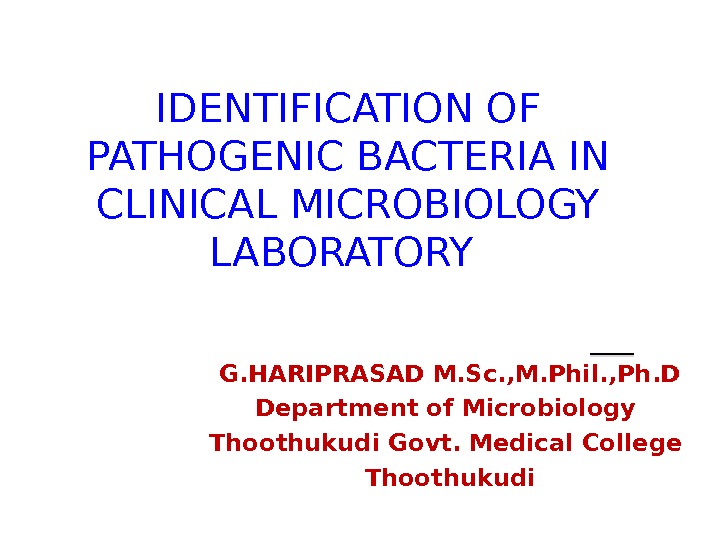
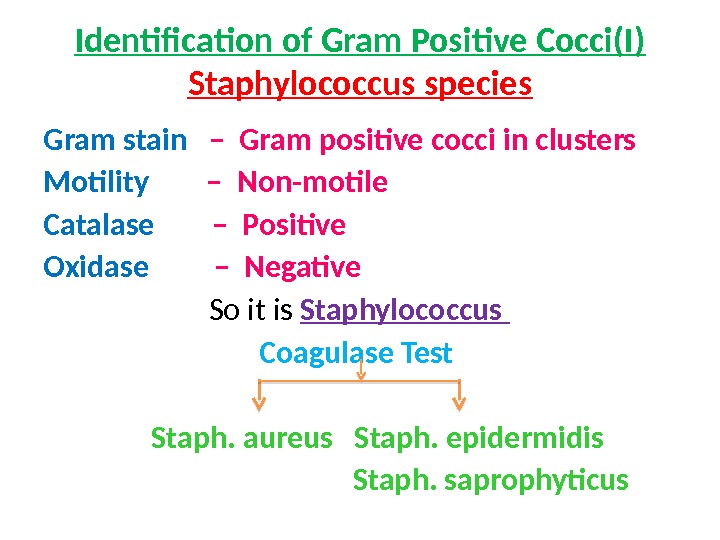

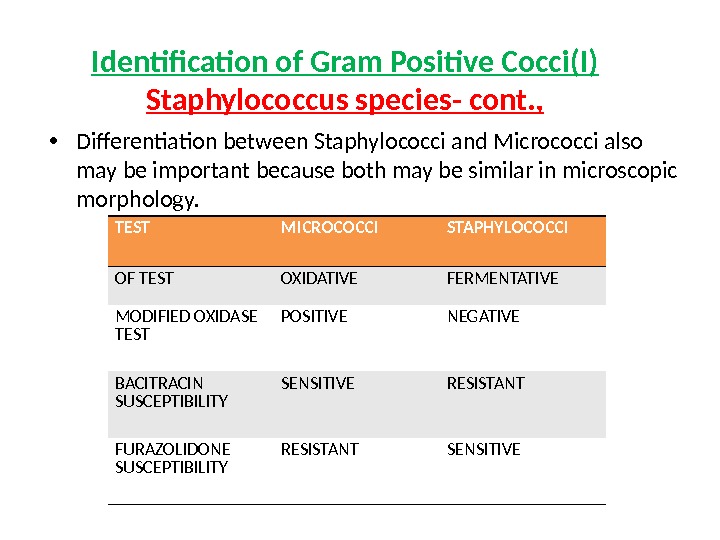

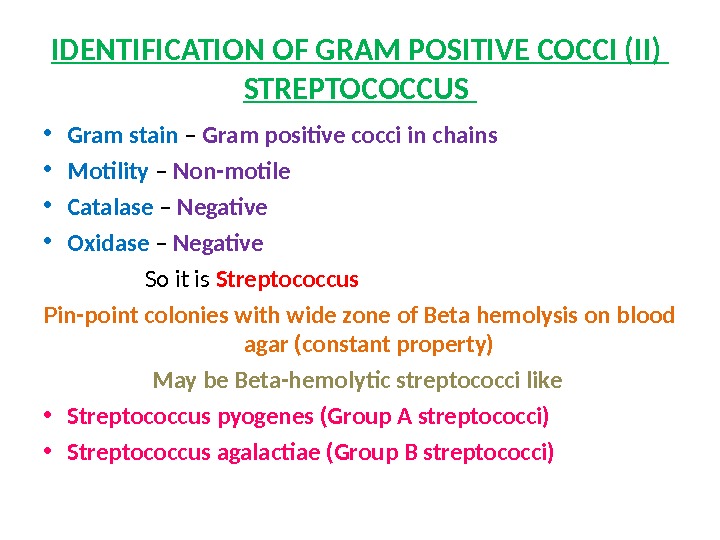
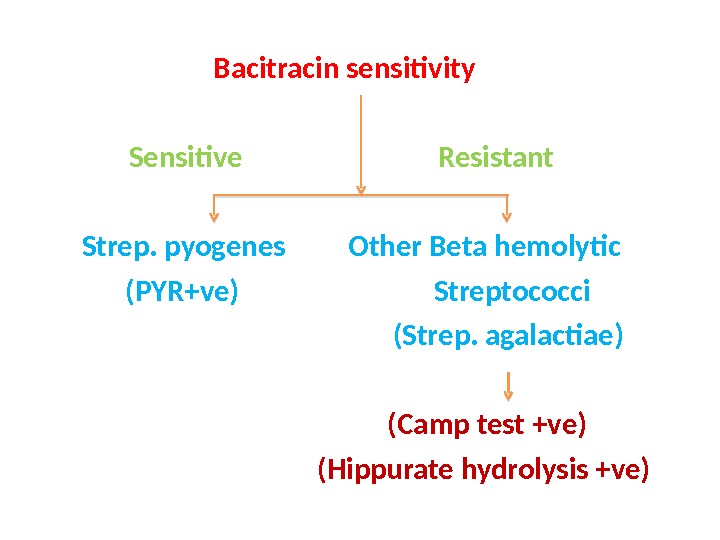
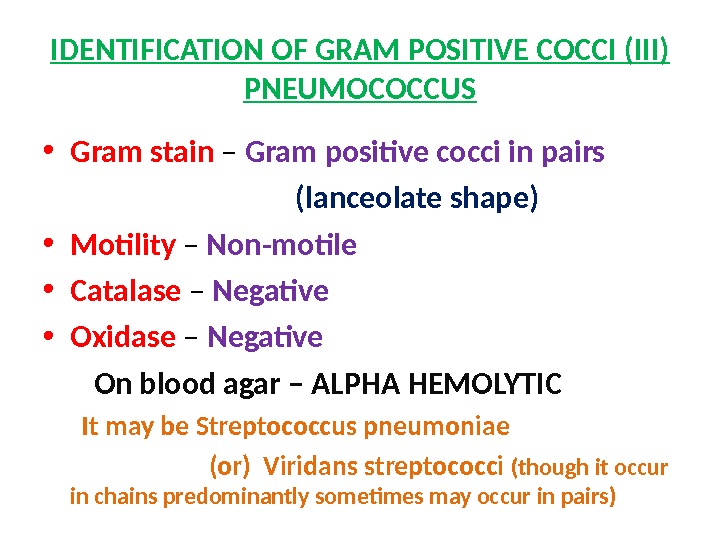

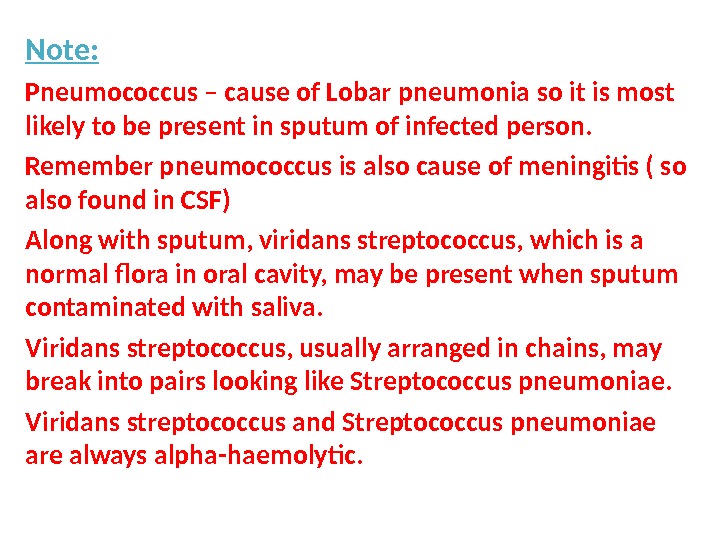
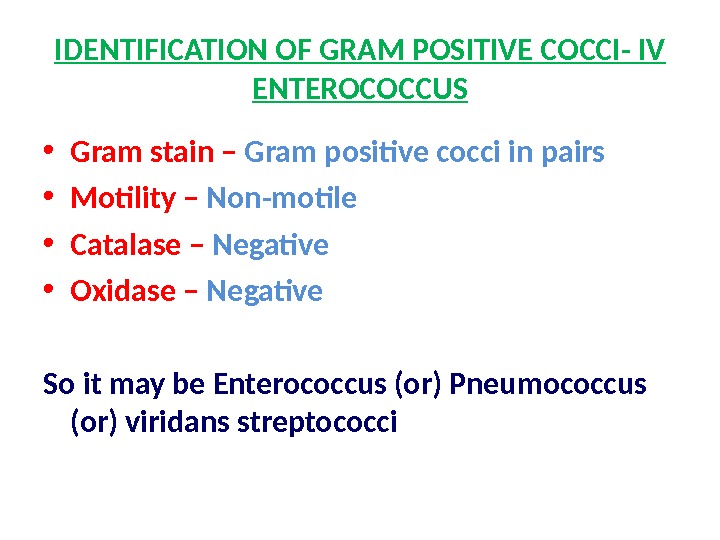
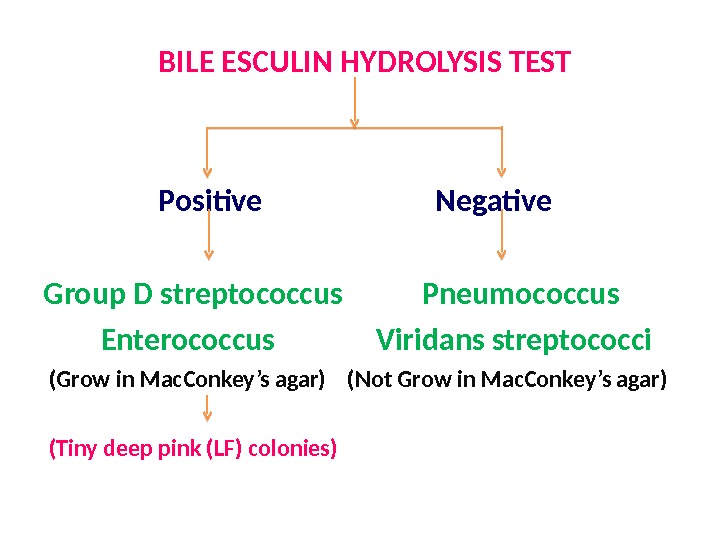
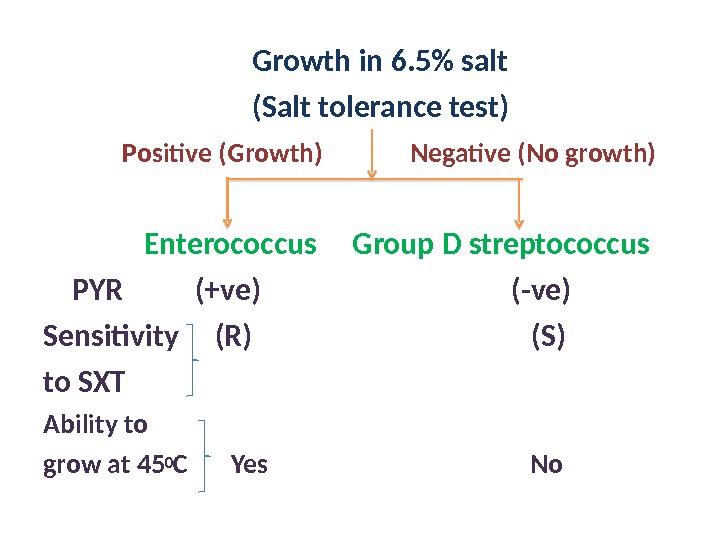
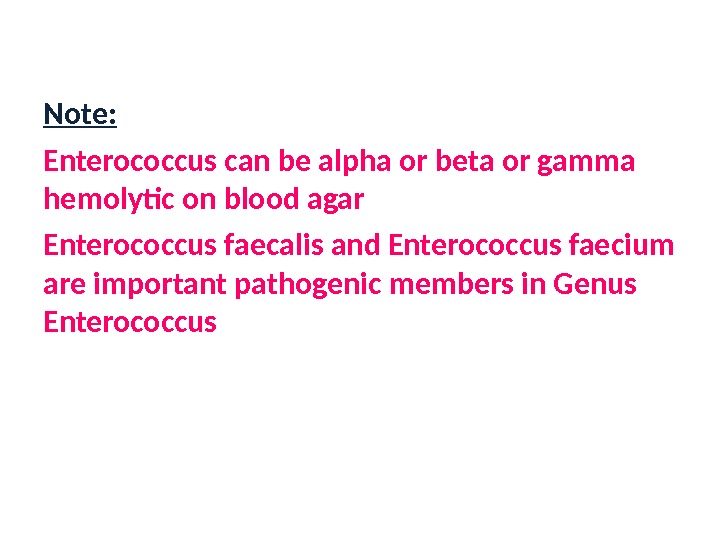


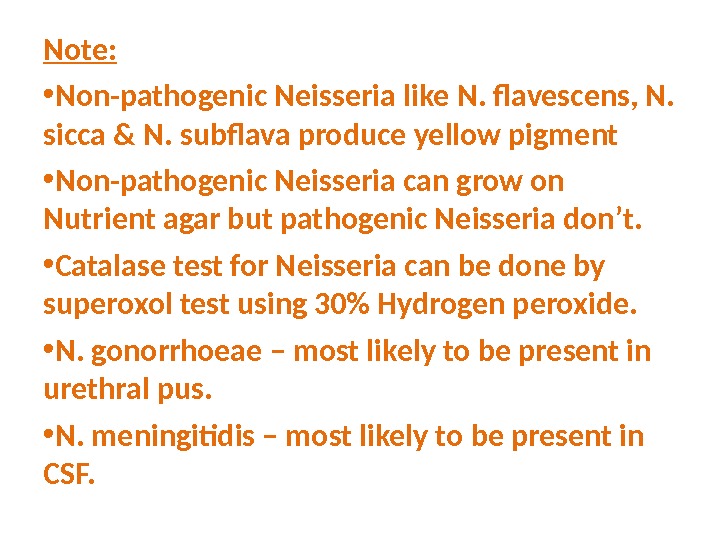
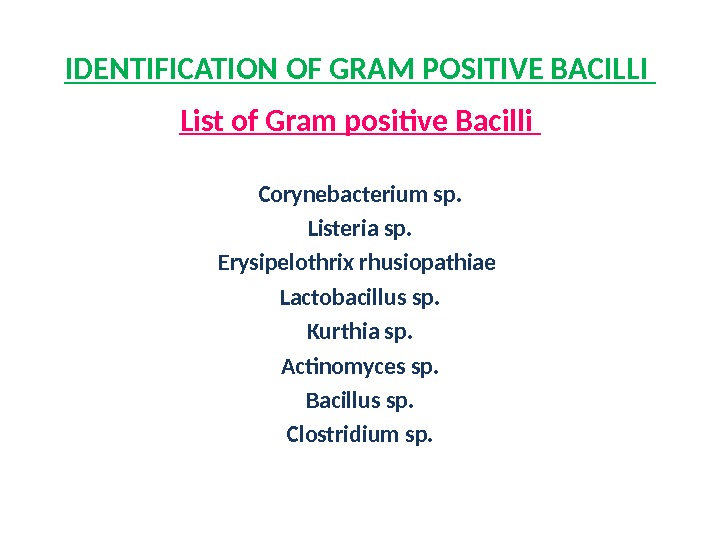
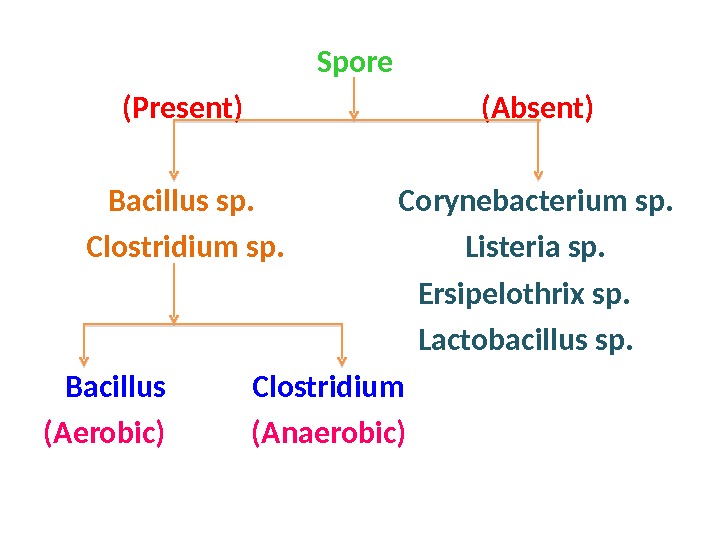
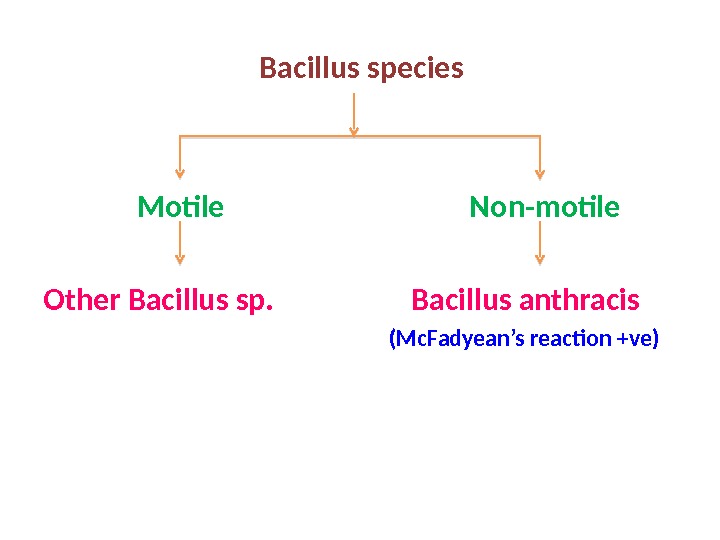
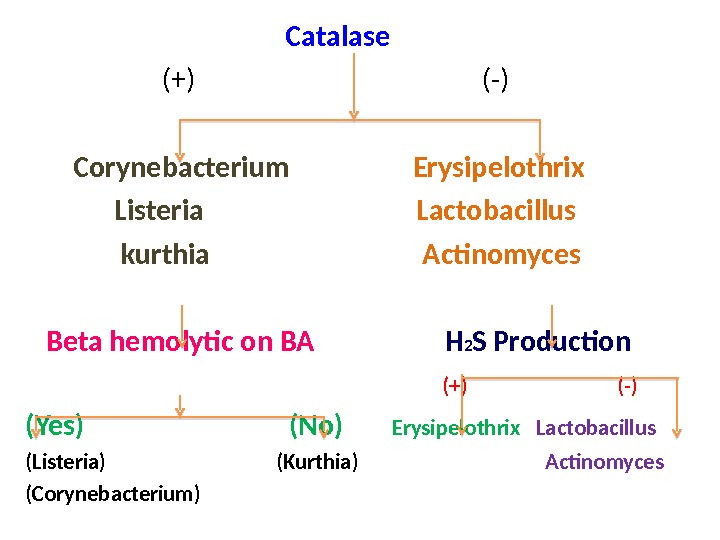
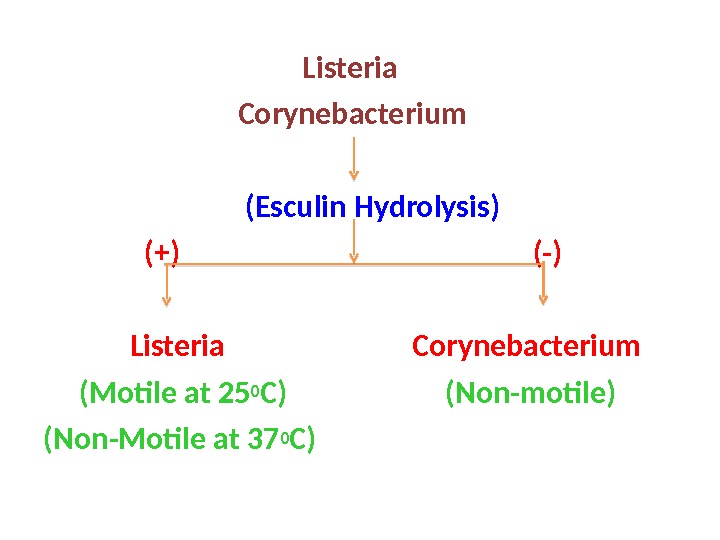
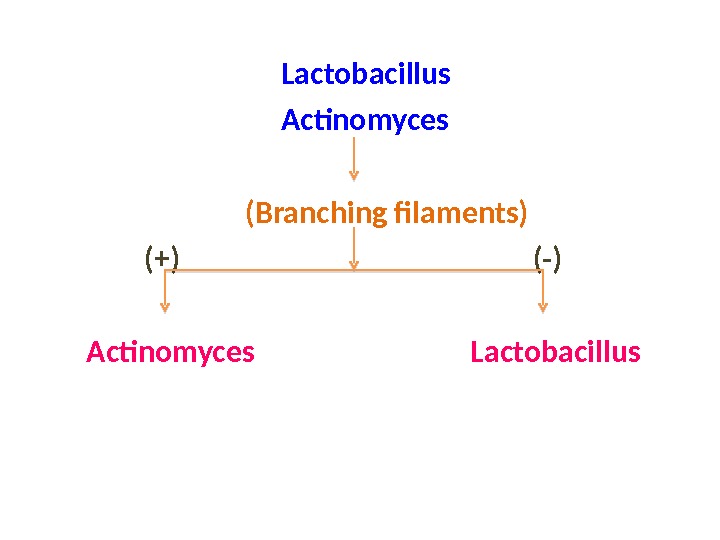

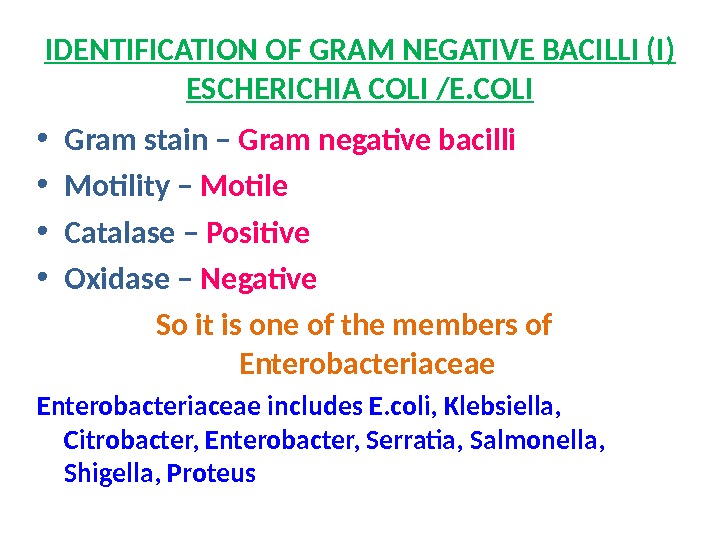
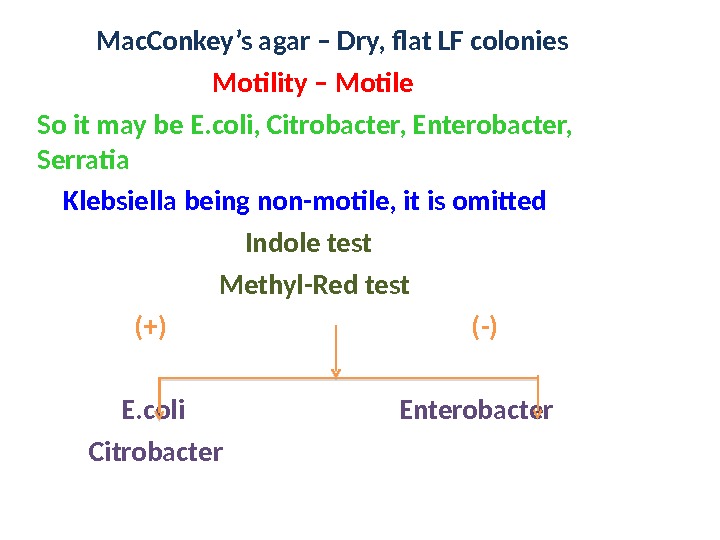
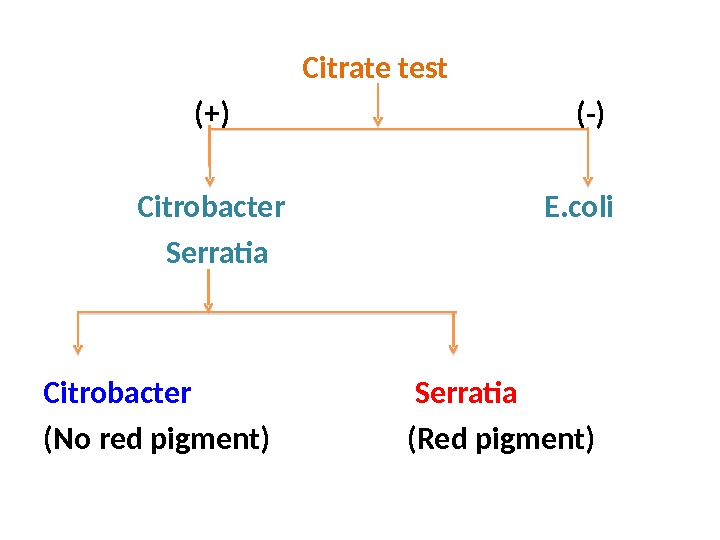
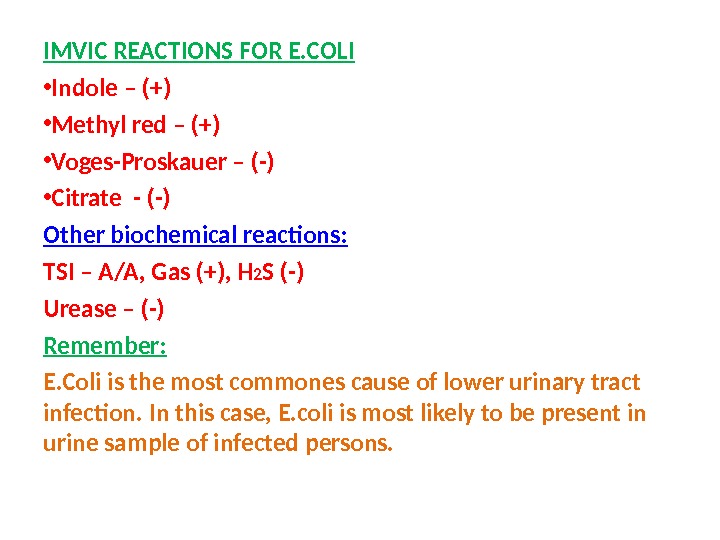

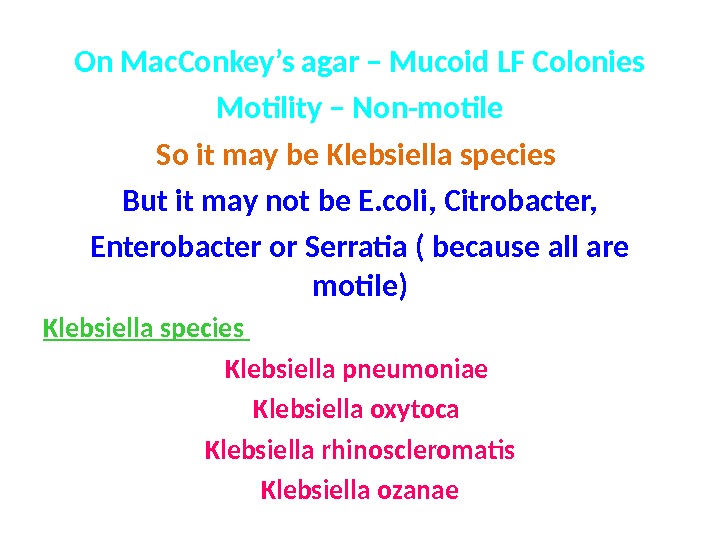
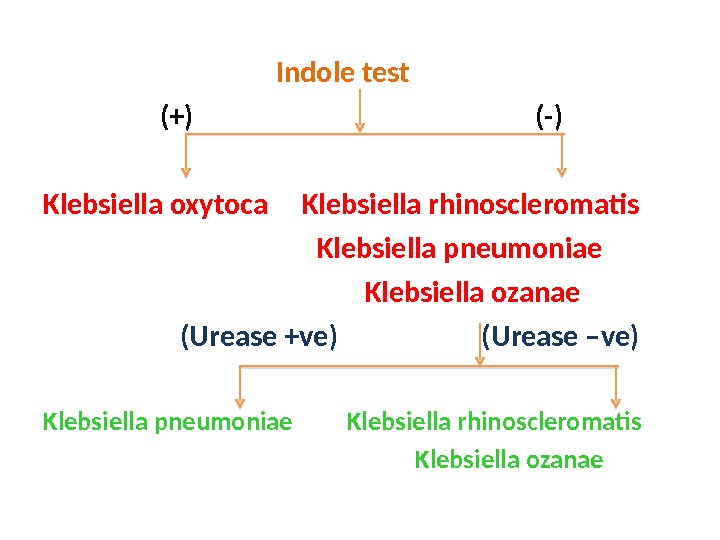
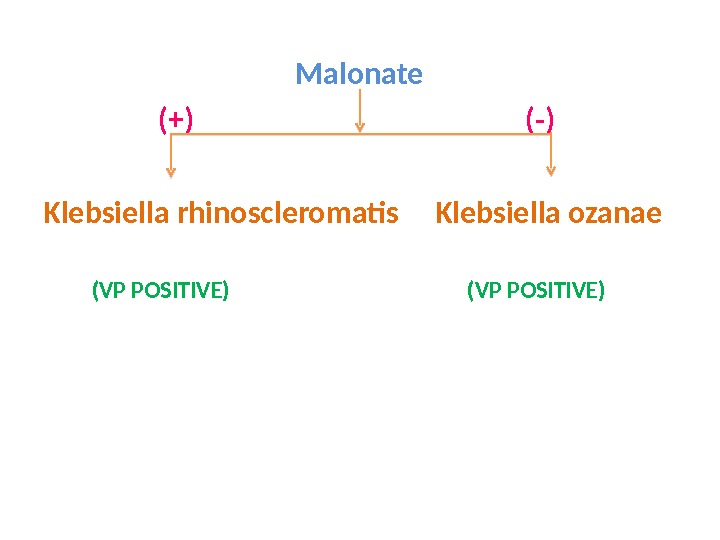

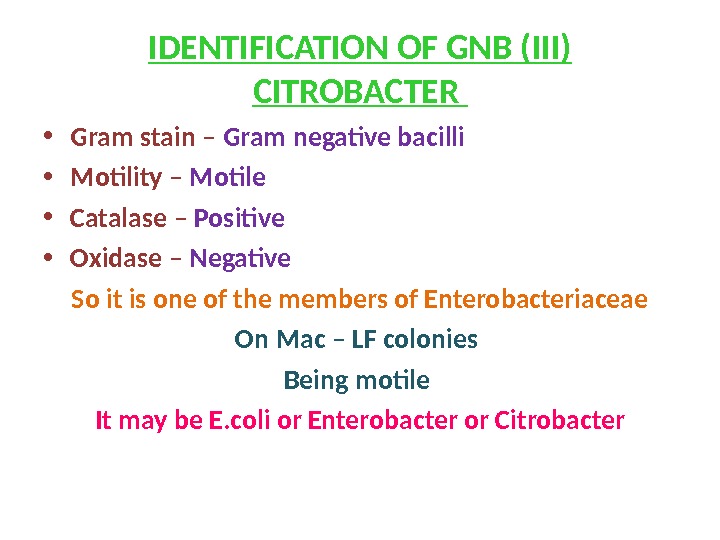
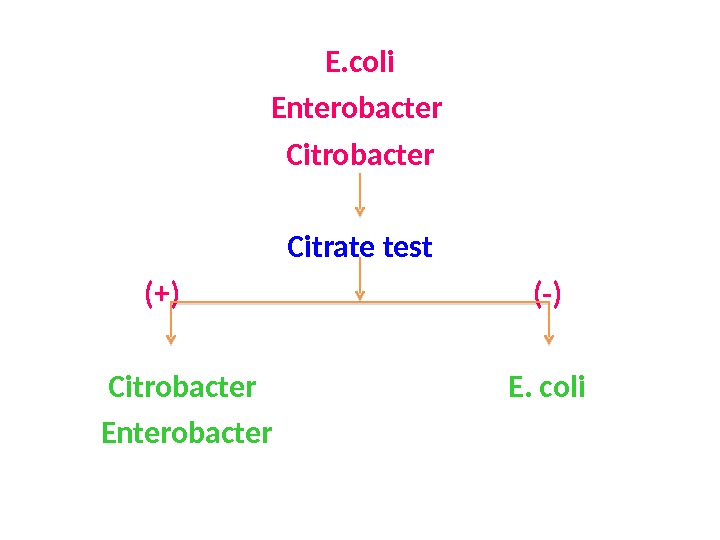
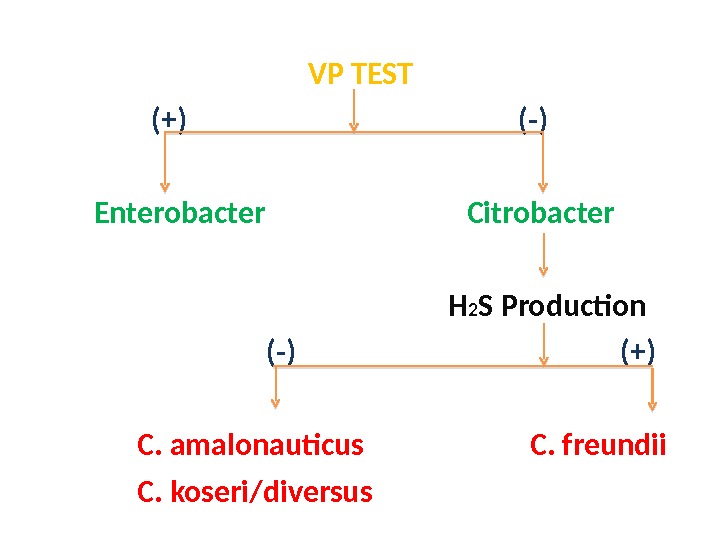
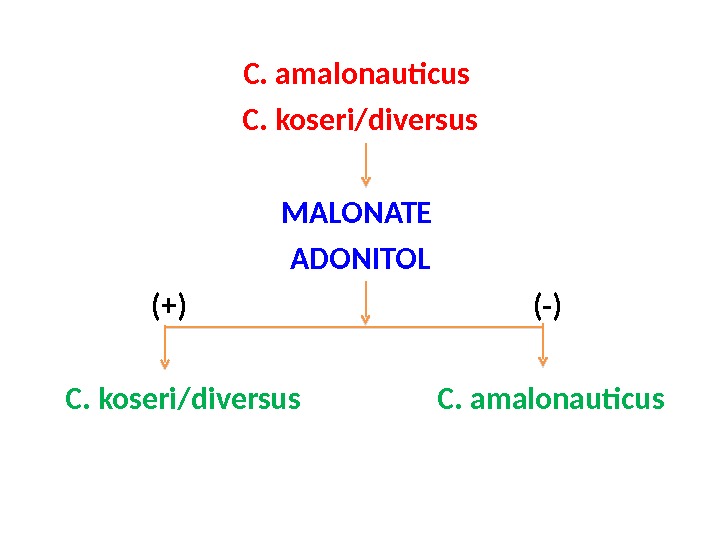

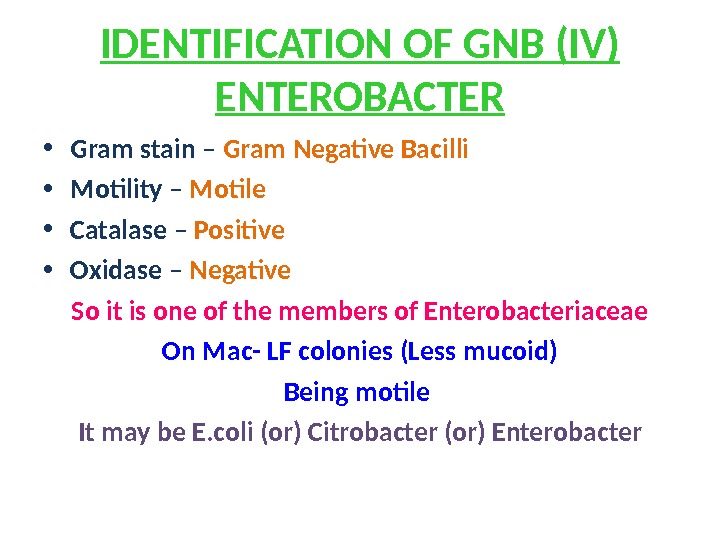


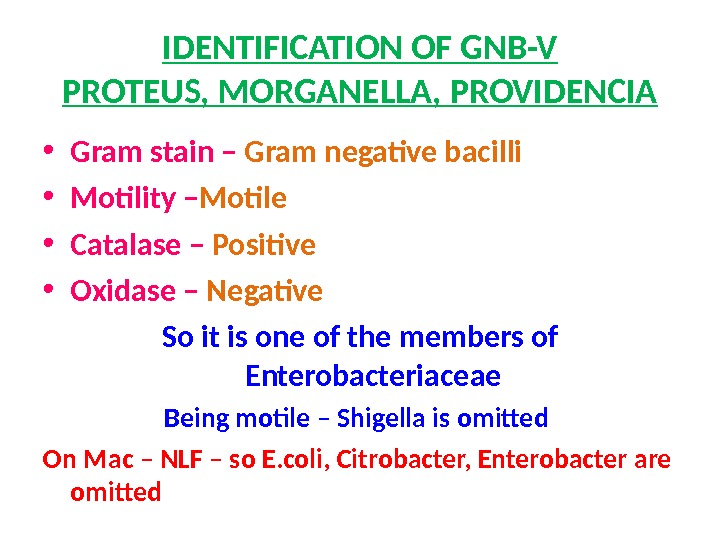
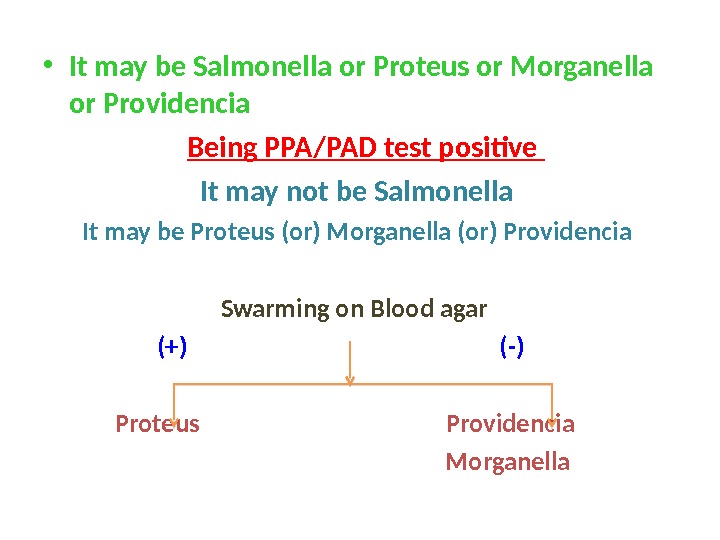
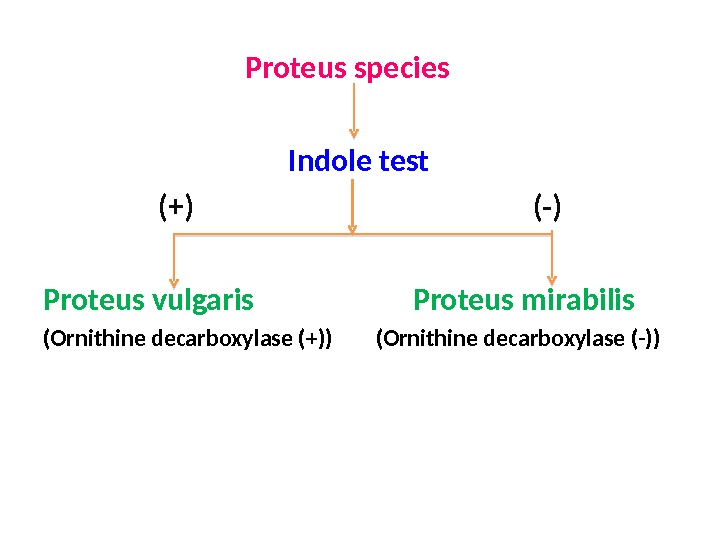

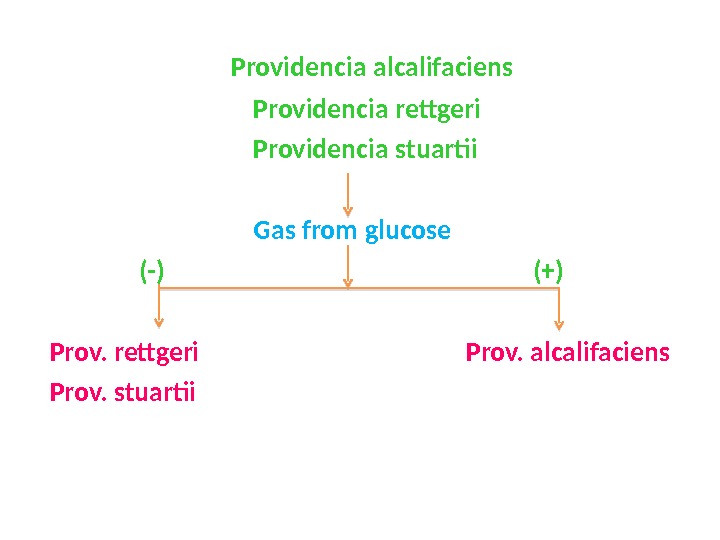
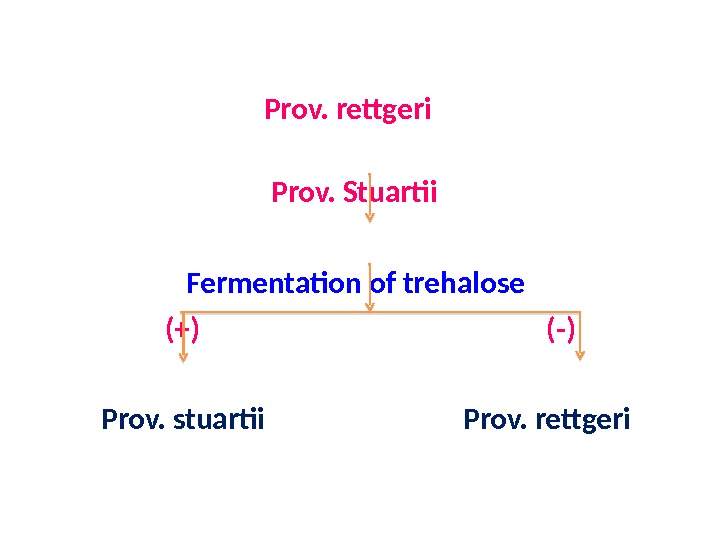
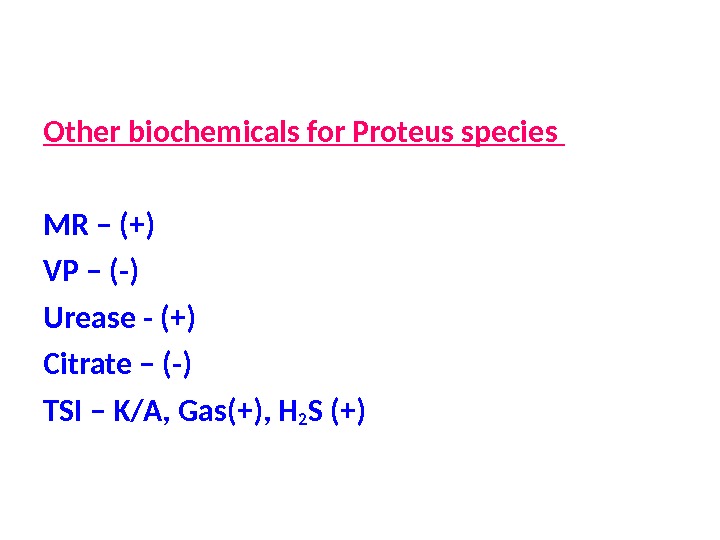
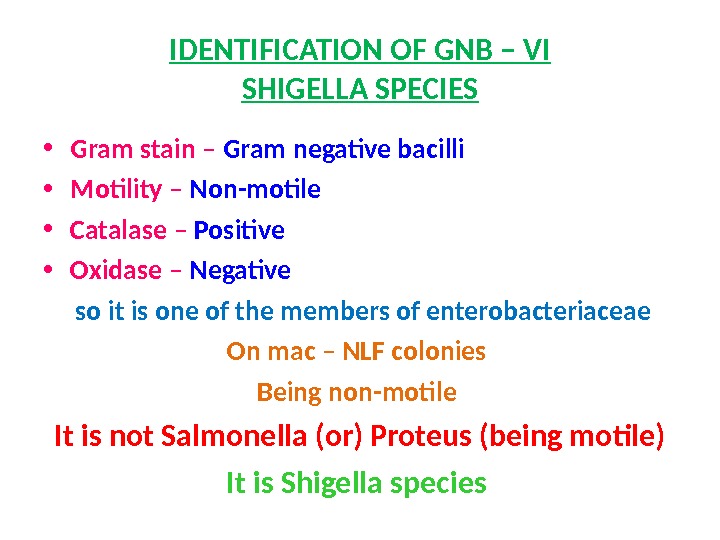
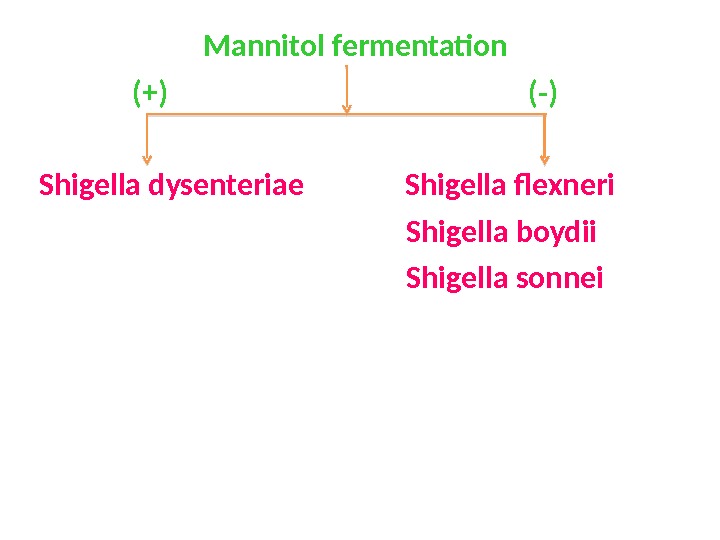
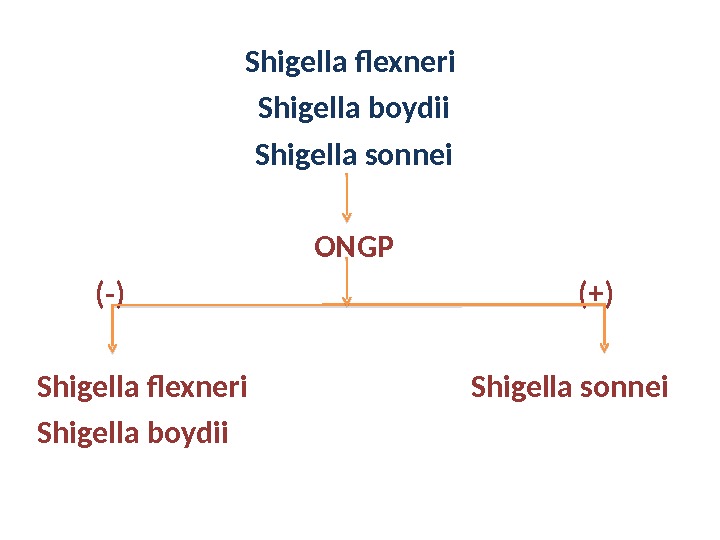
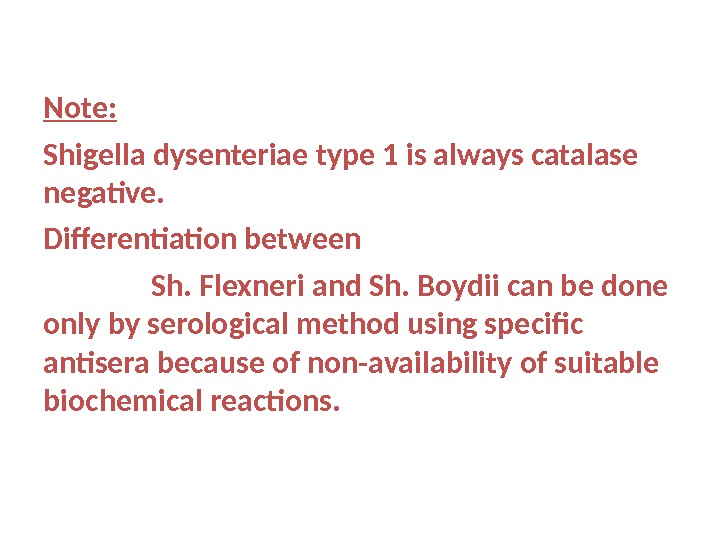
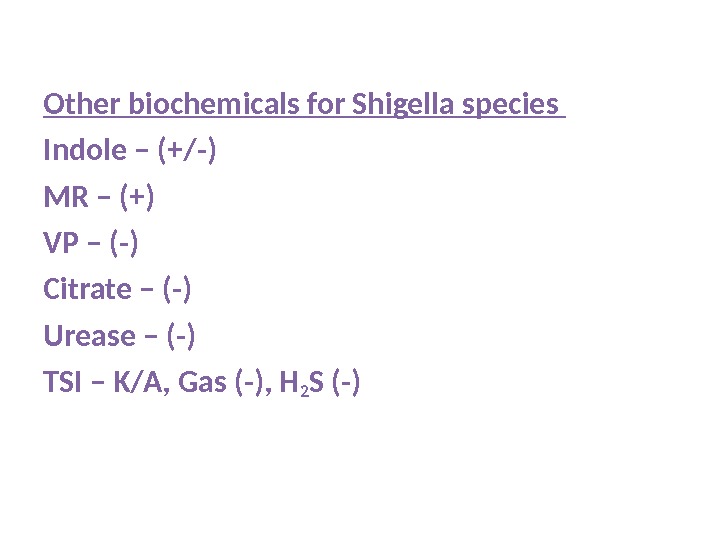
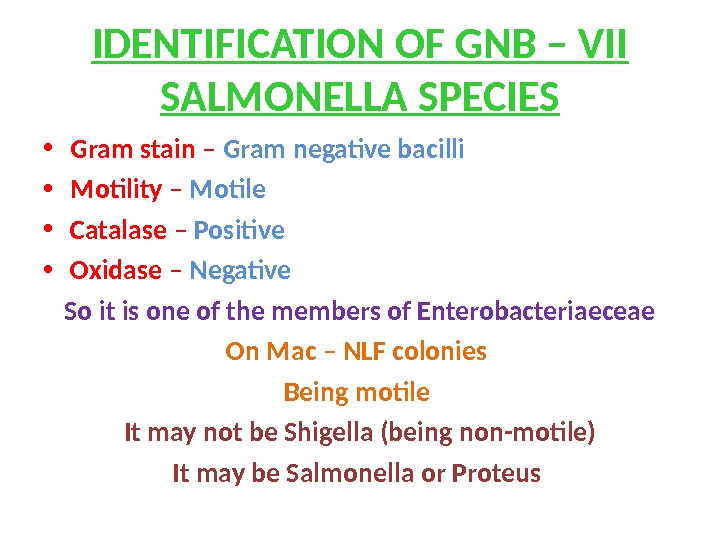
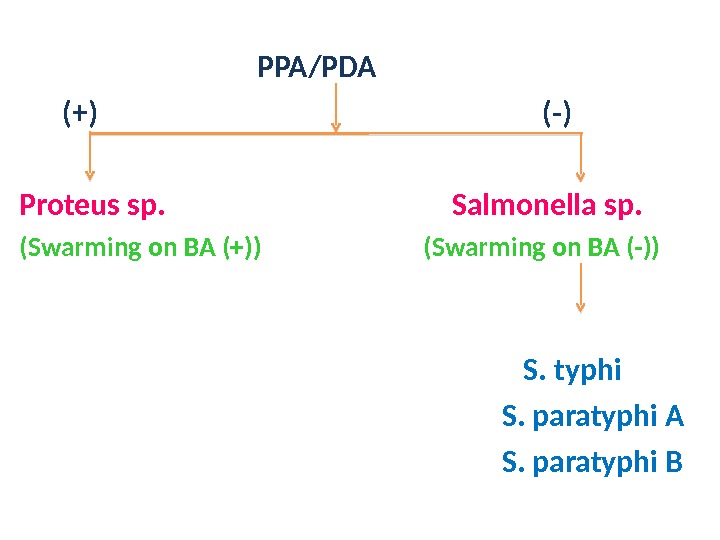
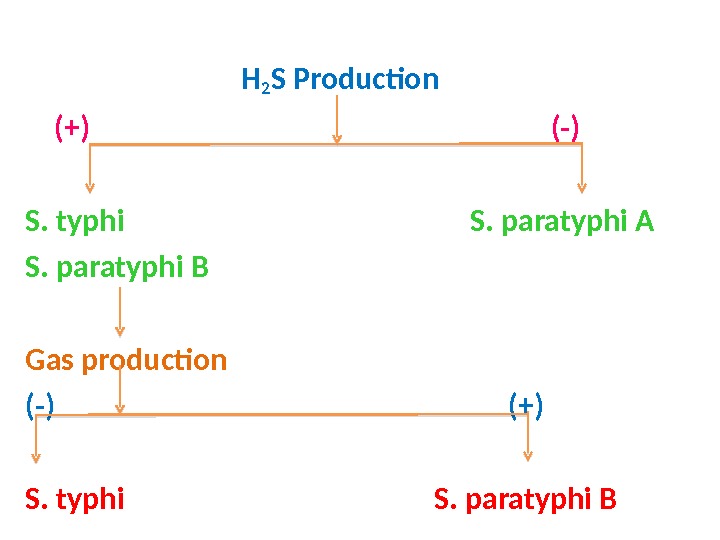
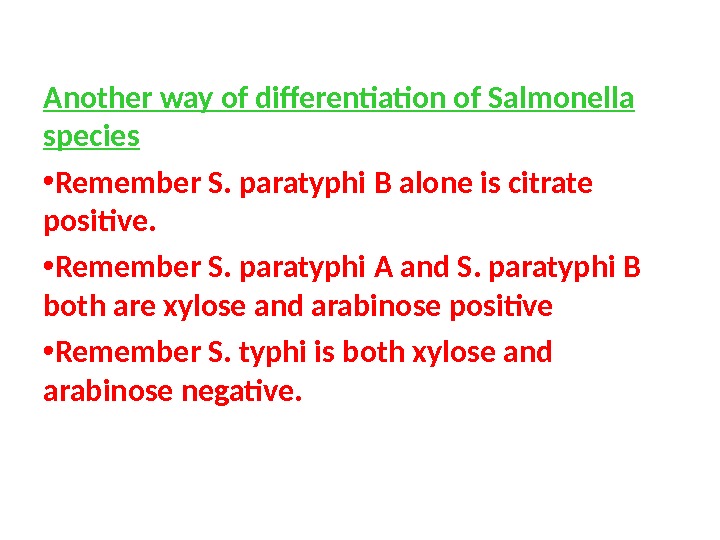

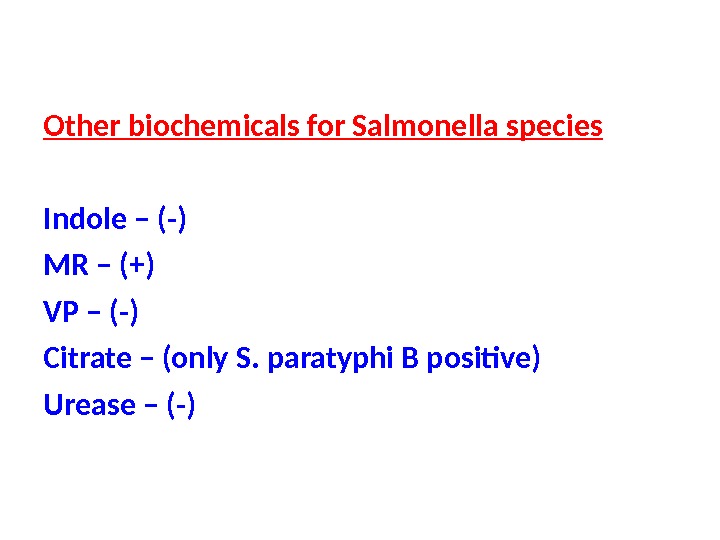
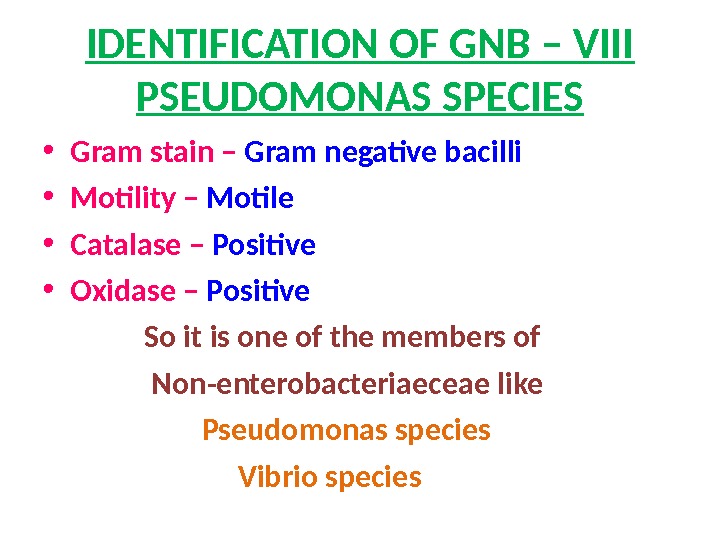
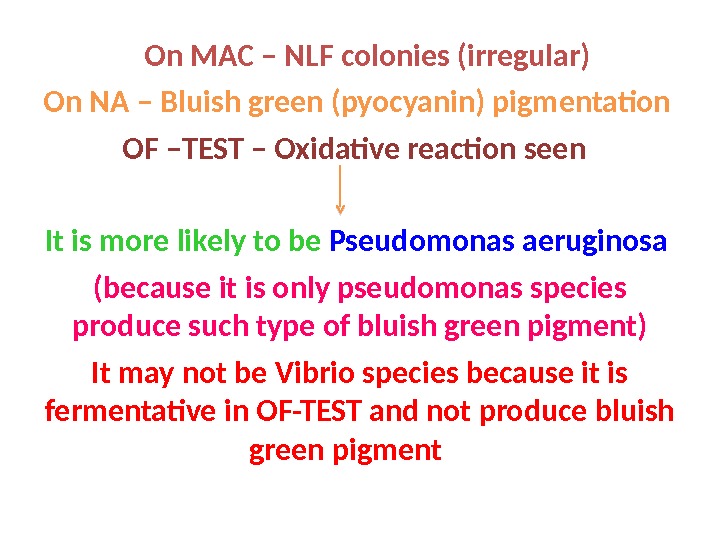
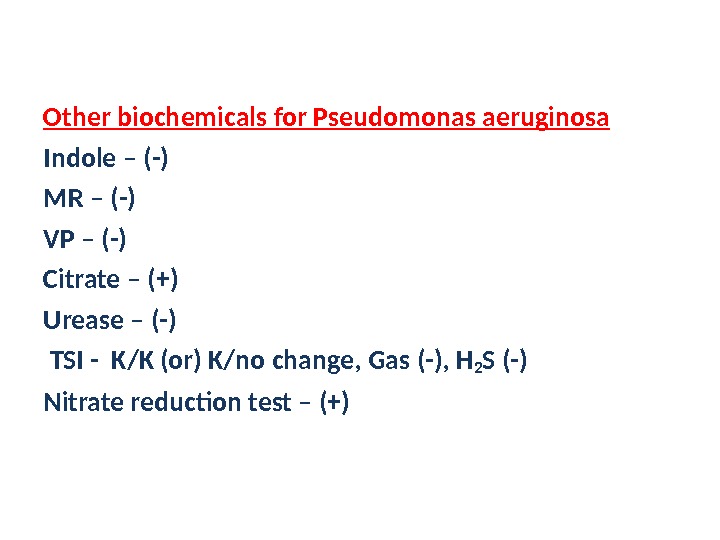
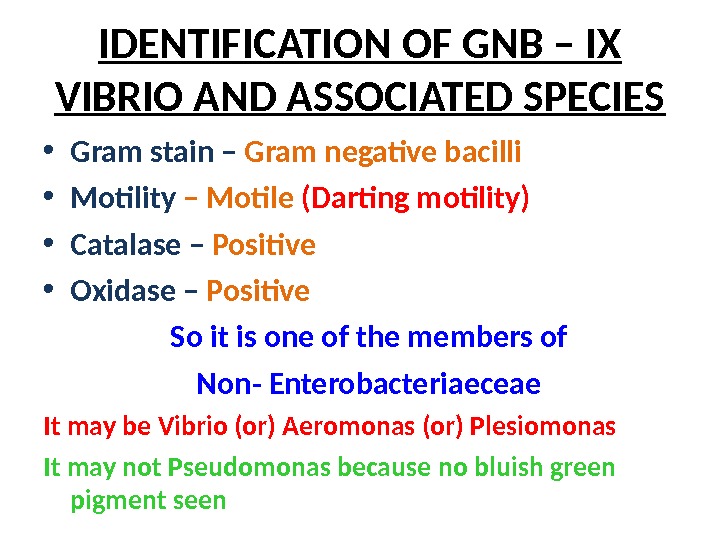
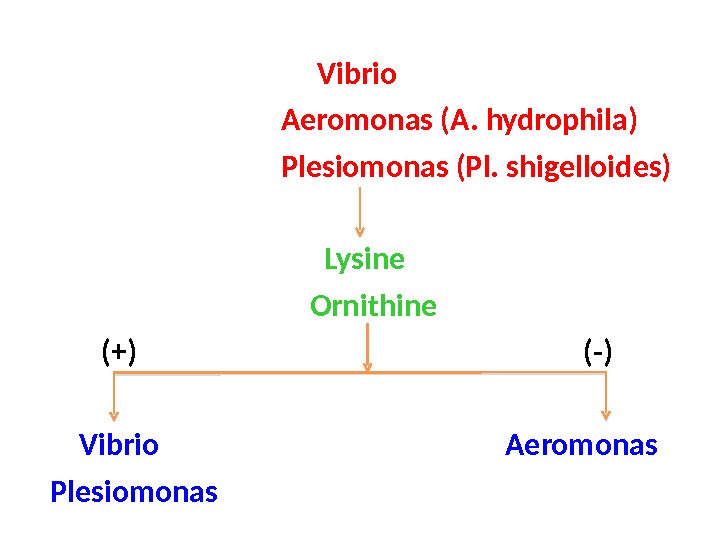
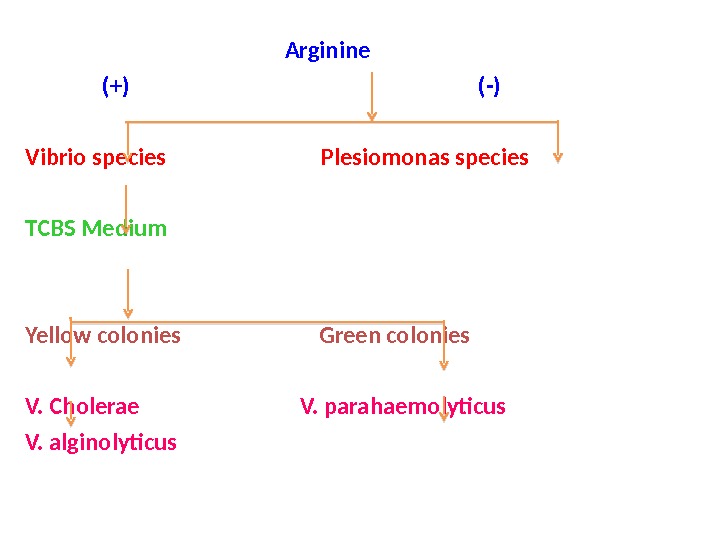

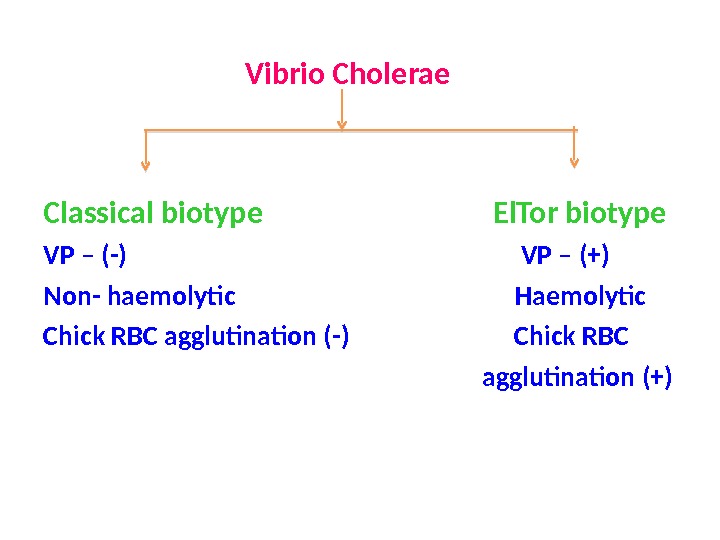
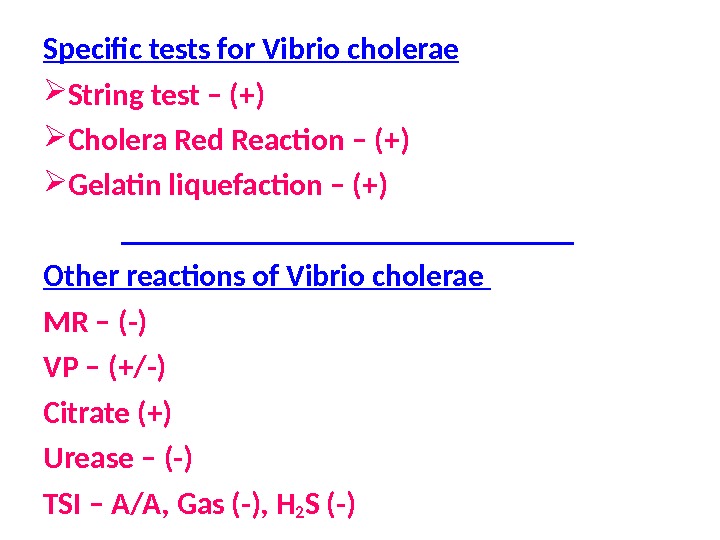
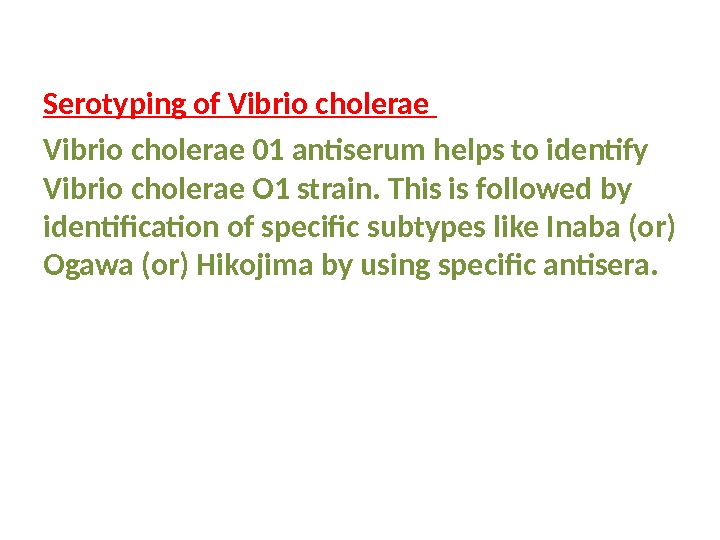
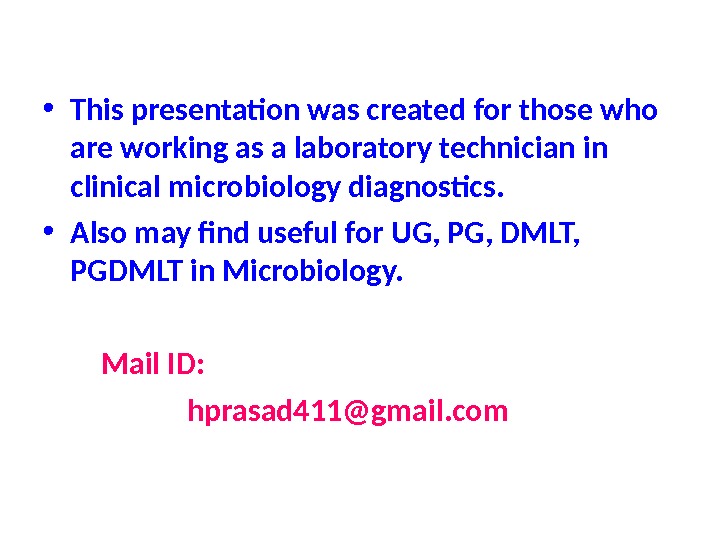
35c2identification_of_bacteria.ppt
- Размер: 750 Кб
- Количество слайдов: 70
Описание презентации IDENTIFICATION OF PATHOGENIC BACTERIA IN CLINICAL MICROBIOLOGY LABORATORY по слайдам
 IDENTIFICATION OF PATHOGENIC BACTERIA IN CLINICAL MICROBIOLOGY LABORATORY G. HARIPRASAD M. Sc. , M. Phil. , Ph. D Department of Microbiology Thoothukudi Govt. Medical College Thoothukudi
IDENTIFICATION OF PATHOGENIC BACTERIA IN CLINICAL MICROBIOLOGY LABORATORY G. HARIPRASAD M. Sc. , M. Phil. , Ph. D Department of Microbiology Thoothukudi Govt. Medical College Thoothukudi
 Identification of Gram Positive Cocci(I) Staphylococcus species Gram stain – Gram positive cocci in clusters Motility – Non-motile Catalase – Positive Oxidase – Negative So it is Staphylococcus Coagulase Test Staph. aureus Staph. epidermidis Staph. saprophyticus
Identification of Gram Positive Cocci(I) Staphylococcus species Gram stain – Gram positive cocci in clusters Motility – Non-motile Catalase – Positive Oxidase – Negative So it is Staphylococcus Coagulase Test Staph. aureus Staph. epidermidis Staph. saprophyticus
 Identification of Gram Positive Cocci(I) Staphylococcus species – cont. , Novobiocin sensitivity Resistant sensitive Staph. Saprophyticus Staph. epidermidis
Identification of Gram Positive Cocci(I) Staphylococcus species – cont. , Novobiocin sensitivity Resistant sensitive Staph. Saprophyticus Staph. epidermidis
 • Differentiation between Staphylococci and Micrococci also may be important because both may be similar in microscopic morphology. TEST MICROCOCCI STAPHYLOCOCCI OF TEST OXIDATIVE FERMENTATIVE MODIFIED OXIDASE TEST POSITIVE NEGATIVE BACITRACIN SUSCEPTIBILITY SENSITIVE RESISTANT FURAZOLIDONE SUSCEPTIBILITY RESISTANT SENSITIVE Identification of Gram Positive Cocci(I) Staphylococcus species- cont. ,
• Differentiation between Staphylococci and Micrococci also may be important because both may be similar in microscopic morphology. TEST MICROCOCCI STAPHYLOCOCCI OF TEST OXIDATIVE FERMENTATIVE MODIFIED OXIDASE TEST POSITIVE NEGATIVE BACITRACIN SUSCEPTIBILITY SENSITIVE RESISTANT FURAZOLIDONE SUSCEPTIBILITY RESISTANT SENSITIVE Identification of Gram Positive Cocci(I) Staphylococcus species- cont. ,
 (contd. . ) Note : Other characteristic features to identify Staphylococcus aureus Mannitol fermentation – Positive DNAase test – Positive Beta-hemolytic on blood agar Golden yellow pigment Mannitol Salt Agar (Selective medium) – Staph. aureus produce yellow color colonies due to mannitol fermentation.
(contd. . ) Note : Other characteristic features to identify Staphylococcus aureus Mannitol fermentation – Positive DNAase test – Positive Beta-hemolytic on blood agar Golden yellow pigment Mannitol Salt Agar (Selective medium) – Staph. aureus produce yellow color colonies due to mannitol fermentation.
 IDENTIFICATION OF GRAM POSITIVE COCCI (II) STREPTOCOCCUS • Gram stain – Gram positive cocci in chains • Motility – Non-motile • Catalase – Negative • Oxidase – Negative So it is Streptococcus Pin-point colonies with wide zone of Beta hemolysis on blood agar (constant property) May be Beta-hemolytic streptococci like • Streptococcus pyogenes (Group A streptococci) • Streptococcus agalactiae (Group B streptococci)
IDENTIFICATION OF GRAM POSITIVE COCCI (II) STREPTOCOCCUS • Gram stain – Gram positive cocci in chains • Motility – Non-motile • Catalase – Negative • Oxidase – Negative So it is Streptococcus Pin-point colonies with wide zone of Beta hemolysis on blood agar (constant property) May be Beta-hemolytic streptococci like • Streptococcus pyogenes (Group A streptococci) • Streptococcus agalactiae (Group B streptococci)
 Bacitracin sensitivity Sensitive Resistant Strep. pyogenes Other Beta hemolytic (PYR+ve) Streptococci (Strep. agalactiae) (Camp test +ve) (Hippurate hydrolysis +ve)
Bacitracin sensitivity Sensitive Resistant Strep. pyogenes Other Beta hemolytic (PYR+ve) Streptococci (Strep. agalactiae) (Camp test +ve) (Hippurate hydrolysis +ve)
 IDENTIFICATION OF GRAM POSITIVE COCCI (III) PNEUMOCOCCUS • Gram stain – Gram positive cocci in pairs (lanceolate shape) • Motility – Non-motile • Catalase – Negative • Oxidase – Negative On blood agar – ALPHA HEMOLYTIC It may be Streptococcus pneumoniae (or) Viridans streptococci (though it occur in chains predominantly sometimes may occur in pairs)
IDENTIFICATION OF GRAM POSITIVE COCCI (III) PNEUMOCOCCUS • Gram stain – Gram positive cocci in pairs (lanceolate shape) • Motility – Non-motile • Catalase – Negative • Oxidase – Negative On blood agar – ALPHA HEMOLYTIC It may be Streptococcus pneumoniae (or) Viridans streptococci (though it occur in chains predominantly sometimes may occur in pairs)
 Optochin sensitivity test (Sensitive) (Resistant) Pneumococcus Viridans streptococci (Capsulated) (Non-capsulated) (Bile solubility test — Pos) (Bile solubility test — Neg) (Capsule swelling test – pos) (Capsule swelling test – Neg) (Bile Esculin test – Neg) (Bile Esculin Negative) Note: Because the isolate is Gram positive cocci in pairs, we may also suspect Enterococcus sp. , which may be alpha, beta or gamma hemolytic pattern on blood agar, hence Bile Esculin test, to which Enterococcus sp. , is positive, can be used.
Optochin sensitivity test (Sensitive) (Resistant) Pneumococcus Viridans streptococci (Capsulated) (Non-capsulated) (Bile solubility test — Pos) (Bile solubility test — Neg) (Capsule swelling test – pos) (Capsule swelling test – Neg) (Bile Esculin test – Neg) (Bile Esculin Negative) Note: Because the isolate is Gram positive cocci in pairs, we may also suspect Enterococcus sp. , which may be alpha, beta or gamma hemolytic pattern on blood agar, hence Bile Esculin test, to which Enterococcus sp. , is positive, can be used.
 Note: Pneumococcus – cause of Lobar pneumonia so it is most likely to be present in sputum of infected person. Remember pneumococcus is also cause of meningitis ( so also found in CSF) Along with sputum, viridans streptococcus, which is a normal flora in oral cavity, may be present when sputum contaminated with saliva. Viridans streptococcus, usually arranged in chains, may break into pairs looking like Streptococcus pneumoniae. Viridans streptococcus and Streptococcus pneumoniae are always alpha-haemolytic.
Note: Pneumococcus – cause of Lobar pneumonia so it is most likely to be present in sputum of infected person. Remember pneumococcus is also cause of meningitis ( so also found in CSF) Along with sputum, viridans streptococcus, which is a normal flora in oral cavity, may be present when sputum contaminated with saliva. Viridans streptococcus, usually arranged in chains, may break into pairs looking like Streptococcus pneumoniae. Viridans streptococcus and Streptococcus pneumoniae are always alpha-haemolytic.
 IDENTIFICATION OF GRAM POSITIVE COCCI- IV ENTEROCOCCUS • Gram stain – Gram positive cocci in pairs • Motility – Non-motile • Catalase – Negative • Oxidase – Negative So it may be Enterococcus (or) Pneumococcus (or) viridans streptococci
IDENTIFICATION OF GRAM POSITIVE COCCI- IV ENTEROCOCCUS • Gram stain – Gram positive cocci in pairs • Motility – Non-motile • Catalase – Negative • Oxidase – Negative So it may be Enterococcus (or) Pneumococcus (or) viridans streptococci
 BILE ESCULIN HYDROLYSIS TEST Positive Negative Group D streptococcus Pneumococcus Enterococcus Viridans streptococci (Grow in Mac. Conkey’s agar) (Not Grow in Mac. Conkey’s agar) (Tiny deep pink (LF) colonies)
BILE ESCULIN HYDROLYSIS TEST Positive Negative Group D streptococcus Pneumococcus Enterococcus Viridans streptococci (Grow in Mac. Conkey’s agar) (Not Grow in Mac. Conkey’s agar) (Tiny deep pink (LF) colonies)
 Growth in 6. 5% salt (Salt tolerance test) Positive (Growth) Negative (No growth) Enterococcus Group D streptococcus PYR (+ve) (-ve) Sensitivity (R) (S) to SXT Ability to grow at 45 0 C Yes No
Growth in 6. 5% salt (Salt tolerance test) Positive (Growth) Negative (No growth) Enterococcus Group D streptococcus PYR (+ve) (-ve) Sensitivity (R) (S) to SXT Ability to grow at 45 0 C Yes No
 Note: Enterococcus can be alpha or beta or gamma hemolytic on blood agar Enterococcus faecalis and Enterococcus faecium are important pathogenic members in Genus Enterococcus
Note: Enterococcus can be alpha or beta or gamma hemolytic on blood agar Enterococcus faecalis and Enterococcus faecium are important pathogenic members in Genus Enterococcus
 IDENTIFICATION OF GRAM NEGATIVE COCCI (I) NEISSERIA SPECIES • Gram Stain – Gram negative diplococci • Motility – Non- motile • Catalase – Positive • Oxidase – Positive So it may be Pathogenic Neisseria (or) Non-pathogenic Neisseria (Neisseria gonorrhoeae) (Neisseria flavescens) (Neisseria meningitidis) (Neisseria sicca) (Neisseria subflava)
IDENTIFICATION OF GRAM NEGATIVE COCCI (I) NEISSERIA SPECIES • Gram Stain – Gram negative diplococci • Motility – Non- motile • Catalase – Positive • Oxidase – Positive So it may be Pathogenic Neisseria (or) Non-pathogenic Neisseria (Neisseria gonorrhoeae) (Neisseria flavescens) (Neisseria meningitidis) (Neisseria sicca) (Neisseria subflava)
 Growth on THAYER-MARTIN MEDIUM (selective medium) Growth No growth Neisseria gonorrhoeae Neisseria flavescens Neisseria meningitidis Neisseria sicca Neisseria subflava Glucose (+ve) Maltose (-ve) Maltose (+ve) N. gonorrhoeae N. meningitidis
Growth on THAYER-MARTIN MEDIUM (selective medium) Growth No growth Neisseria gonorrhoeae Neisseria flavescens Neisseria meningitidis Neisseria sicca Neisseria subflava Glucose (+ve) Maltose (-ve) Maltose (+ve) N. gonorrhoeae N. meningitidis
 Note: • Non-pathogenic Neisseria like N. flavescens, N. sicca & N. subflava produce yellow pigment • Non-pathogenic Neisseria can grow on Nutrient agar but pathogenic Neisseria don’t. • Catalase test for Neisseria can be done by superoxol test using 30% Hydrogen peroxide. • N. gonorrhoeae – most likely to be present in urethral pus. • N. meningitidis – most likely to be present in CSF.
Note: • Non-pathogenic Neisseria like N. flavescens, N. sicca & N. subflava produce yellow pigment • Non-pathogenic Neisseria can grow on Nutrient agar but pathogenic Neisseria don’t. • Catalase test for Neisseria can be done by superoxol test using 30% Hydrogen peroxide. • N. gonorrhoeae – most likely to be present in urethral pus. • N. meningitidis – most likely to be present in CSF.
 IDENTIFICATION OF GRAM POSITIVE BACILLI List of Gram positive Bacilli Corynebacterium sp. Listeria sp. Erysipelothrix rhusiopathiae Lactobacillus sp. Kurthia sp. Actinomyces sp. Bacillus sp. Clostridium sp.
IDENTIFICATION OF GRAM POSITIVE BACILLI List of Gram positive Bacilli Corynebacterium sp. Listeria sp. Erysipelothrix rhusiopathiae Lactobacillus sp. Kurthia sp. Actinomyces sp. Bacillus sp. Clostridium sp.
 Spore (Present) (Absent) Bacillus sp. Corynebacterium sp. Clostridium sp. Listeria sp. Ersipelothrix sp. Lactobacillus sp. Bacillus Clostridium (Aerobic) (Anaerobic)
Spore (Present) (Absent) Bacillus sp. Corynebacterium sp. Clostridium sp. Listeria sp. Ersipelothrix sp. Lactobacillus sp. Bacillus Clostridium (Aerobic) (Anaerobic)
 Bacillus species Motile Non-motile Other Bacillus sp. Bacillus anthracis (Mc. Fadyean’s reaction +ve)
Bacillus species Motile Non-motile Other Bacillus sp. Bacillus anthracis (Mc. Fadyean’s reaction +ve)
 Catalase (+) (-) Corynebacterium Erysipelothrix Listeria Lactobacillus kurthia Actinomyces Beta hemolytic on BA H 2 S Production (+) (-) (Yes) (No) Erysipelothrix Lactobacillus (Listeria) (Kurthia) Actinomyces (Corynebacterium)
Catalase (+) (-) Corynebacterium Erysipelothrix Listeria Lactobacillus kurthia Actinomyces Beta hemolytic on BA H 2 S Production (+) (-) (Yes) (No) Erysipelothrix Lactobacillus (Listeria) (Kurthia) Actinomyces (Corynebacterium)
 Listeria Corynebacterium (Esculin Hydrolysis) (+) (-) Listeria Corynebacterium (Motile at 250 C) (Non-motile) (Non-Motile at 37 0 C)
Listeria Corynebacterium (Esculin Hydrolysis) (+) (-) Listeria Corynebacterium (Motile at 250 C) (Non-motile) (Non-Motile at 37 0 C)
 Lactobacillus Actinomyces (Branching filaments) (+) (-) Actinomyces Lactobacillus
Lactobacillus Actinomyces (Branching filaments) (+) (-) Actinomyces Lactobacillus
 Note: Other examples of anaerobic Gram positive bacilli – Eubacterium, Propionibacterium, Bifidobacterium, Mobilincus. Remember, Actinomyces and Lactobacillus also contains anaerobic species and microaerophilic species. Clostridium species (anaerobes) – another example of Gram positive bacilli Diptheroids, morphologically similar to C. diptheriae can grow on ordinary media like Nutrient agar. But Corynebacterium diptheriae can only grow on enriched media like Blood agar and Loeffler serum slope.
Note: Other examples of anaerobic Gram positive bacilli – Eubacterium, Propionibacterium, Bifidobacterium, Mobilincus. Remember, Actinomyces and Lactobacillus also contains anaerobic species and microaerophilic species. Clostridium species (anaerobes) – another example of Gram positive bacilli Diptheroids, morphologically similar to C. diptheriae can grow on ordinary media like Nutrient agar. But Corynebacterium diptheriae can only grow on enriched media like Blood agar and Loeffler serum slope.
 IDENTIFICATION OF GRAM NEGATIVE BACILLI (I) ESCHERICHIA COLI /E. COLI • Gram stain – Gram negative bacilli • Motility – Motile • Catalase – Positive • Oxidase – Negative So it is one of the members of Enterobacteriaceae includes E. coli, Klebsiella, Citrobacter, Enterobacter, Serratia, Salmonella, Shigella, Proteus
IDENTIFICATION OF GRAM NEGATIVE BACILLI (I) ESCHERICHIA COLI /E. COLI • Gram stain – Gram negative bacilli • Motility – Motile • Catalase – Positive • Oxidase – Negative So it is one of the members of Enterobacteriaceae includes E. coli, Klebsiella, Citrobacter, Enterobacter, Serratia, Salmonella, Shigella, Proteus
 Mac. Conkey’s agar – Dry, flat LF colonies Motility – Motile So it may be E. coli, Citrobacter, Enterobacter, Serratia Klebsiella being non-motile, it is omitted Indole test Methyl-Red test (+) (-) E. coli Enterobacter Citrobacter
Mac. Conkey’s agar – Dry, flat LF colonies Motility – Motile So it may be E. coli, Citrobacter, Enterobacter, Serratia Klebsiella being non-motile, it is omitted Indole test Methyl-Red test (+) (-) E. coli Enterobacter Citrobacter
 Citrate test (+) (-) Citrobacter E. coli Serratia Citrobacter Serratia (No red pigment) (Red pigment)
Citrate test (+) (-) Citrobacter E. coli Serratia Citrobacter Serratia (No red pigment) (Red pigment)
 IMVIC REACTIONS FOR E. COLI • Indole – (+) • Methyl red – (+) • Voges-Proskauer – (-) • Citrate — (-) Other biochemical reactions: TSI – A/A, Gas (+), H 2 S (-) Urease – (-) Remember: E. Coli is the most commones cause of lower urinary tract infection. In this case, E. coli is most likely to be present in urine sample of infected persons.
IMVIC REACTIONS FOR E. COLI • Indole – (+) • Methyl red – (+) • Voges-Proskauer – (-) • Citrate — (-) Other biochemical reactions: TSI – A/A, Gas (+), H 2 S (-) Urease – (-) Remember: E. Coli is the most commones cause of lower urinary tract infection. In this case, E. coli is most likely to be present in urine sample of infected persons.
 IDENTIFICATION OF GNB (II) KLEBSIELLA SPECIES • Gram stain – Gram Negative bacilli • Motility – Non-motile • Catalase – Positive • Oxidase – Negative So it is one of the members of Enterobacteriaceae
IDENTIFICATION OF GNB (II) KLEBSIELLA SPECIES • Gram stain – Gram Negative bacilli • Motility – Non-motile • Catalase – Positive • Oxidase – Negative So it is one of the members of Enterobacteriaceae
 On Mac. Conkey’s agar – Mucoid LF Colonies Motility – Non-motile So it may be Klebsiella species But it may not be E. coli, Citrobacter, Enterobacter or Serratia ( because all are motile) Klebsiella species Klebsiella pneumoniae Klebsiella oxytoca Klebsiella rhinoscleromatis Klebsiella ozanae
On Mac. Conkey’s agar – Mucoid LF Colonies Motility – Non-motile So it may be Klebsiella species But it may not be E. coli, Citrobacter, Enterobacter or Serratia ( because all are motile) Klebsiella species Klebsiella pneumoniae Klebsiella oxytoca Klebsiella rhinoscleromatis Klebsiella ozanae
 Indole test (+) (-) Klebsiella oxytoca Klebsiella rhinoscleromatis Klebsiella pneumoniae Klebsiella ozanae (Urease +ve) (Urease –ve) Klebsiella pneumoniae Klebsiella rhinoscleromatis Klebsiella ozanae
Indole test (+) (-) Klebsiella oxytoca Klebsiella rhinoscleromatis Klebsiella pneumoniae Klebsiella ozanae (Urease +ve) (Urease –ve) Klebsiella pneumoniae Klebsiella rhinoscleromatis Klebsiella ozanae
 Malonate (+) (-) Klebsiella rhinoscleromatis Klebsiella ozanae (VP POSITIVE)
Malonate (+) (-) Klebsiella rhinoscleromatis Klebsiella ozanae (VP POSITIVE)
 IMVIC REACTIONS FOR KLEBSIELLA PNEUMONIAE • Indole – (-) • Methyl red – (-) • Voges-Proskauer – (+) • Citrate — (+) Other biochemical reactions: TSI – A/A, Gas (+), H 2 S (-) Urease – (+) Remember: Klebsiella pneumoniae is also the most commonest cause of lower urinary tract infection. In this case, it is most likely to be present in urine sample of infected persons.
IMVIC REACTIONS FOR KLEBSIELLA PNEUMONIAE • Indole – (-) • Methyl red – (-) • Voges-Proskauer – (+) • Citrate — (+) Other biochemical reactions: TSI – A/A, Gas (+), H 2 S (-) Urease – (+) Remember: Klebsiella pneumoniae is also the most commonest cause of lower urinary tract infection. In this case, it is most likely to be present in urine sample of infected persons.
 IDENTIFICATION OF GNB (III) CITROBACTER • Gram stain – Gram negative bacilli • Motility – Motile • Catalase – Positive • Oxidase – Negative So it is one of the members of Enterobacteriaceae On Mac – LF colonies Being motile It may be E. coli or Enterobacter or Citrobacter
IDENTIFICATION OF GNB (III) CITROBACTER • Gram stain – Gram negative bacilli • Motility – Motile • Catalase – Positive • Oxidase – Negative So it is one of the members of Enterobacteriaceae On Mac – LF colonies Being motile It may be E. coli or Enterobacter or Citrobacter
 E. coli Enterobacter Citrate test (+) (-) Citrobacter E. coli Enterobacter
E. coli Enterobacter Citrate test (+) (-) Citrobacter E. coli Enterobacter
 VP TEST (+) (-) Enterobacter Citrobacter H 2 S Production (-) (+) C. amalonauticus C. freundii C. koseri/diversus
VP TEST (+) (-) Enterobacter Citrobacter H 2 S Production (-) (+) C. amalonauticus C. freundii C. koseri/diversus
 C. amalonauticus C. koseri/diversus MALONATE ADONITOL (+) (-) C. koseri/diversus C. amalonauticus
C. amalonauticus C. koseri/diversus MALONATE ADONITOL (+) (-) C. koseri/diversus C. amalonauticus
 Other reactions of Citrobacter • Indole – (+/-) • MR – (+) • VP – (-) • Urease – (weakly positive) • TSI – A/A, Gas (+ve), H 2 S (+/-) Remember citrobacter sometimes also may be Late lactose fermenter ( ONPG – +VE) Remember Citrobacter always Citrobacter (+)
Other reactions of Citrobacter • Indole – (+/-) • MR – (+) • VP – (-) • Urease – (weakly positive) • TSI – A/A, Gas (+ve), H 2 S (+/-) Remember citrobacter sometimes also may be Late lactose fermenter ( ONPG – +VE) Remember Citrobacter always Citrobacter (+)
 IDENTIFICATION OF GNB (IV) ENTEROBACTER • Gram stain – Gram Negative Bacilli • Motility – Motile • Catalase – Positive • Oxidase – Negative So it is one of the members of Enterobacteriaceae On Mac- LF colonies (Less mucoid) Being motile It may be E. coli (or) Citrobacter (or) Enterobacter
IDENTIFICATION OF GNB (IV) ENTEROBACTER • Gram stain – Gram Negative Bacilli • Motility – Motile • Catalase – Positive • Oxidase – Negative So it is one of the members of Enterobacteriaceae On Mac- LF colonies (Less mucoid) Being motile It may be E. coli (or) Citrobacter (or) Enterobacter
 CITRATE TEST (+) (-) Citrobacter E. coli Enterobacter VP TEST (+) (-) Enterobacter Citrobacter
CITRATE TEST (+) (-) Citrobacter E. coli Enterobacter VP TEST (+) (-) Enterobacter Citrobacter
 Enterobacter cloacae Enterobacter aerogenes Lysine (+) (-) Ent. aerogenes Ent. Cloacae (Arginine- Pos) (Arginine- Neg)
Enterobacter cloacae Enterobacter aerogenes Lysine (+) (-) Ent. aerogenes Ent. Cloacae (Arginine- Pos) (Arginine- Neg)
 IDENTIFICATION OF GNB-V PROTEUS, MORGANELLA, PROVIDENCIA • Gram stain – Gram negative bacilli • Motility – Motile • Catalase – Positive • Oxidase – Negative So it is one of the members of Enterobacteriaceae Being motile – Shigella is omitted On Mac – NLF – so E. coli, Citrobacter, Enterobacter are omitted
IDENTIFICATION OF GNB-V PROTEUS, MORGANELLA, PROVIDENCIA • Gram stain – Gram negative bacilli • Motility – Motile • Catalase – Positive • Oxidase – Negative So it is one of the members of Enterobacteriaceae Being motile – Shigella is omitted On Mac – NLF – so E. coli, Citrobacter, Enterobacter are omitted
 • It may be Salmonella or Proteus or Morganella or Providencia Being PPA/PAD test positive It may not be Salmonella It may be Proteus (or) Morganella (or) Providencia Swarming on Blood agar (+) (-) Proteus Providencia Morganella
• It may be Salmonella or Proteus or Morganella or Providencia Being PPA/PAD test positive It may not be Salmonella It may be Proteus (or) Morganella (or) Providencia Swarming on Blood agar (+) (-) Proteus Providencia Morganella
 Proteus species Indole test (+) (-) Proteus vulgaris Proteus mirabilis (Ornithine decarboxylase (+)) (Ornithine decarboxylase (-))
Proteus species Indole test (+) (-) Proteus vulgaris Proteus mirabilis (Ornithine decarboxylase (+)) (Ornithine decarboxylase (-))
 Morganella Providencia Ornithine decarboxylase (+) (-) Morganella morgani Prov. alcalifaciens Prov. rettgeri Prov. stuartii
Morganella Providencia Ornithine decarboxylase (+) (-) Morganella morgani Prov. alcalifaciens Prov. rettgeri Prov. stuartii
 Providencia alcalifaciens Providencia rettgeri Providencia stuartii Gas from glucose (-) (+) Prov. rettgeri Prov. alcalifaciens Prov. stuartii
Providencia alcalifaciens Providencia rettgeri Providencia stuartii Gas from glucose (-) (+) Prov. rettgeri Prov. alcalifaciens Prov. stuartii
 Prov. rettgeri Prov. Stuartii Fermentation of trehalose (+) (-) Prov. stuartii Prov. rettgeri
Prov. rettgeri Prov. Stuartii Fermentation of trehalose (+) (-) Prov. stuartii Prov. rettgeri
 Other biochemicals for Proteus species MR – (+) VP – (-) Urease — (+) Citrate – (-) TSI – K/A, Gas(+), H 2 S (+)
Other biochemicals for Proteus species MR – (+) VP – (-) Urease — (+) Citrate – (-) TSI – K/A, Gas(+), H 2 S (+)
 IDENTIFICATION OF GNB – VI SHIGELLA SPECIES • Gram stain – Gram negative bacilli • Motility – Non-motile • Catalase – Positive • Oxidase – Negative so it is one of the members of enterobacteriaceae On mac – NLF colonies Being non-motile It is not Salmonella (or) Proteus (being motile) It is Shigella species
IDENTIFICATION OF GNB – VI SHIGELLA SPECIES • Gram stain – Gram negative bacilli • Motility – Non-motile • Catalase – Positive • Oxidase – Negative so it is one of the members of enterobacteriaceae On mac – NLF colonies Being non-motile It is not Salmonella (or) Proteus (being motile) It is Shigella species
 Mannitol fermentation (+) (-) Shigella dysenteriae Shigella flexneri Shigella boydii Shigella sonnei
Mannitol fermentation (+) (-) Shigella dysenteriae Shigella flexneri Shigella boydii Shigella sonnei
 Shigella flexneri Shigella boydii Shigella sonnei ONGP (-) (+) Shigella flexneri Shigella sonnei Shigella boydii
Shigella flexneri Shigella boydii Shigella sonnei ONGP (-) (+) Shigella flexneri Shigella sonnei Shigella boydii
 Note: Shigella dysenteriae type 1 is always catalase negative. Differentiation between Sh. Flexneri and Sh. Boydii can be done only by serological method using specific antisera because of non-availability of suitable biochemical reactions.
Note: Shigella dysenteriae type 1 is always catalase negative. Differentiation between Sh. Flexneri and Sh. Boydii can be done only by serological method using specific antisera because of non-availability of suitable biochemical reactions.
 Other biochemicals for Shigella species Indole – (+/-) MR – (+) VP – (-) Citrate – (-) Urease – (-) TSI – K/A, Gas (-), H 2 S (-)
Other biochemicals for Shigella species Indole – (+/-) MR – (+) VP – (-) Citrate – (-) Urease – (-) TSI – K/A, Gas (-), H 2 S (-)
 IDENTIFICATION OF GNB – VII SALMONELLA SPECIES • Gram stain – Gram negative bacilli • Motility – Motile • Catalase – Positive • Oxidase – Negative So it is one of the members of Enterobacteriaeceae On Mac – NLF colonies Being motile It may not be Shigella (being non-motile) It may be Salmonella or Proteus
IDENTIFICATION OF GNB – VII SALMONELLA SPECIES • Gram stain – Gram negative bacilli • Motility – Motile • Catalase – Positive • Oxidase – Negative So it is one of the members of Enterobacteriaeceae On Mac – NLF colonies Being motile It may not be Shigella (being non-motile) It may be Salmonella or Proteus
 PPA/PDA (+) (-) Proteus sp. Salmonella sp. (Swarming on BA (+)) (Swarming on BA (-)) S. typhi S. paratyphi A S. paratyphi
PPA/PDA (+) (-) Proteus sp. Salmonella sp. (Swarming on BA (+)) (Swarming on BA (-)) S. typhi S. paratyphi A S. paratyphi
 H 2 S Production (+) (-) S. typhi S. paratyphi A S. paratyphi B Gas production (-) (+) S. typhi S. paratyphi
H 2 S Production (+) (-) S. typhi S. paratyphi A S. paratyphi B Gas production (-) (+) S. typhi S. paratyphi
 Another way of differentiation of Salmonella species • Remember S. paratyphi B alone is citrate positive. • Remember S. paratyphi A and S. paratyphi B both are xylose and arabinose positive • Remember S. typhi is both xylose and arabinose negative.
Another way of differentiation of Salmonella species • Remember S. paratyphi B alone is citrate positive. • Remember S. paratyphi A and S. paratyphi B both are xylose and arabinose positive • Remember S. typhi is both xylose and arabinose negative.
 Differentiation of Salmonella species also may be possible by TSI reaction S. typhi K/A, Gas (-), speck of H 2 S (+) S. paratyphi A K/A, Gas (+), H 2 S (-) S. paratyphi B K/A, Gas (+), abundant H 2 S (+)
Differentiation of Salmonella species also may be possible by TSI reaction S. typhi K/A, Gas (-), speck of H 2 S (+) S. paratyphi A K/A, Gas (+), H 2 S (-) S. paratyphi B K/A, Gas (+), abundant H 2 S (+)
 Other biochemicals for Salmonella species Indole – (-) MR – (+) VP – (-) Citrate – (only S. paratyphi B positive) Urease – (-)
Other biochemicals for Salmonella species Indole – (-) MR – (+) VP – (-) Citrate – (only S. paratyphi B positive) Urease – (-)
 IDENTIFICATION OF GNB – VIII PSEUDOMONAS SPECIES • Gram stain – Gram negative bacilli • Motility – Motile • Catalase – Positive • Oxidase – Positive So it is one of the members of Non-enterobacteriaeceae like Pseudomonas species Vibrio species
IDENTIFICATION OF GNB – VIII PSEUDOMONAS SPECIES • Gram stain – Gram negative bacilli • Motility – Motile • Catalase – Positive • Oxidase – Positive So it is one of the members of Non-enterobacteriaeceae like Pseudomonas species Vibrio species
 On MAC – NLF colonies (irregular) On NA – Bluish green (pyocyanin) pigmentation OF –TEST – Oxidative reaction seen It is more likely to be Pseudomonas aeruginosa (because it is only pseudomonas species produce such type of bluish green pigment) It may not be Vibrio species because it is fermentative in OF-TEST and not produce bluish green pigment
On MAC – NLF colonies (irregular) On NA – Bluish green (pyocyanin) pigmentation OF –TEST – Oxidative reaction seen It is more likely to be Pseudomonas aeruginosa (because it is only pseudomonas species produce such type of bluish green pigment) It may not be Vibrio species because it is fermentative in OF-TEST and not produce bluish green pigment
 Other biochemicals for Pseudomonas aeruginosa Indole – (-) MR – (-) VP – (-) Citrate – (+) Urease – (-) TSI — K/K (or) K/no change, Gas (-), H 2 S (-) Nitrate reduction test – (+)
Other biochemicals for Pseudomonas aeruginosa Indole – (-) MR – (-) VP – (-) Citrate – (+) Urease – (-) TSI — K/K (or) K/no change, Gas (-), H 2 S (-) Nitrate reduction test – (+)
 IDENTIFICATION OF GNB – IX VIBRIO AND ASSOCIATED SPECIES • Gram stain – Gram negative bacilli • Motility – Motile (Darting motility) • Catalase – Positive • Oxidase – Positive So it is one of the members of Non- Enterobacteriaeceae It may be Vibrio (or) Aeromonas (or) Plesiomonas It may not Pseudomonas because no bluish green pigment seen
IDENTIFICATION OF GNB – IX VIBRIO AND ASSOCIATED SPECIES • Gram stain – Gram negative bacilli • Motility – Motile (Darting motility) • Catalase – Positive • Oxidase – Positive So it is one of the members of Non- Enterobacteriaeceae It may be Vibrio (or) Aeromonas (or) Plesiomonas It may not Pseudomonas because no bluish green pigment seen
 Vibrio Aeromonas (A. hydrophila) Plesiomonas (Pl. shigelloides) Lysine Ornithine (+) (-) Vibrio Aeromonas Plesiomonas
Vibrio Aeromonas (A. hydrophila) Plesiomonas (Pl. shigelloides) Lysine Ornithine (+) (-) Vibrio Aeromonas Plesiomonas
 Arginine (+) (-) Vibrio species Plesiomonas species TCBS Medium Yellow colonies Green colonies V. Cholerae V. parahaemolyticus V. alginolyticus
Arginine (+) (-) Vibrio species Plesiomonas species TCBS Medium Yellow colonies Green colonies V. Cholerae V. parahaemolyticus V. alginolyticus
 Vibrio cholerae Vibrio alginolyticus Swarming on Blood agar (+) (-) V. alginolyticus V. cholerae Two biotypes Classical El. Tor
Vibrio cholerae Vibrio alginolyticus Swarming on Blood agar (+) (-) V. alginolyticus V. cholerae Two biotypes Classical El. Tor
 Vibrio Cholerae Classical biotype El. Tor biotype VP – (-) VP – (+) Non- haemolytic Haemolytic Chick RBC agglutination (-) Chick RBC agglutination (+)
Vibrio Cholerae Classical biotype El. Tor biotype VP – (-) VP – (+) Non- haemolytic Haemolytic Chick RBC agglutination (-) Chick RBC agglutination (+)
 Specific tests for Vibrio cholerae String test – (+) Cholera Red Reaction – (+) Gelatin liquefaction – (+) _______________ Other reactions of Vibrio cholerae MR – (-) VP – (+/-) Citrate (+) Urease – (-) TSI – A/A, Gas (-), H 2 S (-)
Specific tests for Vibrio cholerae String test – (+) Cholera Red Reaction – (+) Gelatin liquefaction – (+) _______________ Other reactions of Vibrio cholerae MR – (-) VP – (+/-) Citrate (+) Urease – (-) TSI – A/A, Gas (-), H 2 S (-)
 Serotyping of Vibrio cholerae 01 antiserum helps to identify Vibrio cholerae O 1 strain. This is followed by identification of specific subtypes like Inaba (or) Ogawa (or) Hikojima by using specific antisera.
Serotyping of Vibrio cholerae 01 antiserum helps to identify Vibrio cholerae O 1 strain. This is followed by identification of specific subtypes like Inaba (or) Ogawa (or) Hikojima by using specific antisera.
 • This presentation was created for those who are working as a laboratory technician in clinical microbiology diagnostics. • Also may find useful for UG, PG, DMLT, PGDMLT in Microbiology. Mail ID: hprasad 411@gmail. com
• This presentation was created for those who are working as a laboratory technician in clinical microbiology diagnostics. • Also may find useful for UG, PG, DMLT, PGDMLT in Microbiology. Mail ID: hprasad 411@gmail. com

